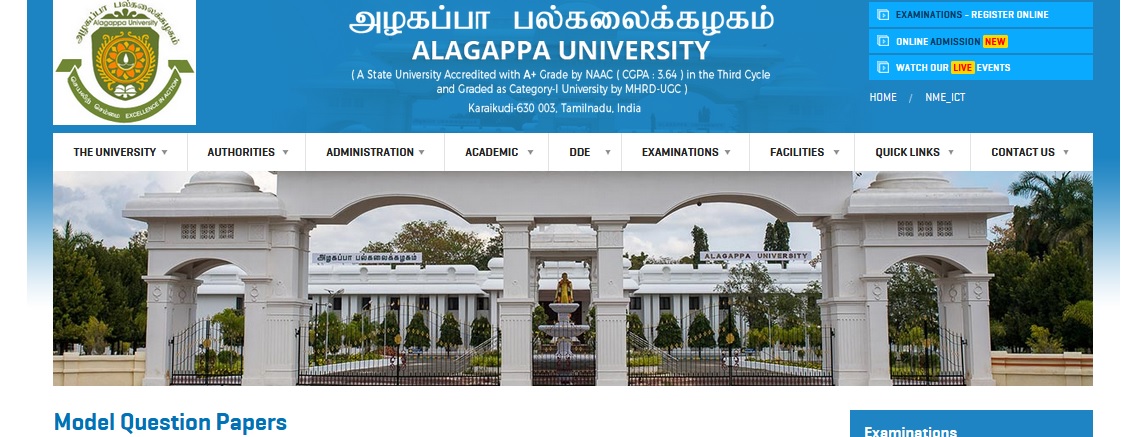Genetics And Molecular Biology M.Sc Model Question Papers : alagappauniversity.ac.in
Name of the University : Alagappa University
Degree : M.Sc
Department : Biology
Subject Code/Name : Genetics And Molecular Biology
Document Type : Model Question Papers
Website : alagappauniversity.ac.in
Download Model/Sample Question Paper : APRIL2011 :https://www.pdfquestion.in/uploads/alagappauniversity.ac.in/4165.-1-M.Sc.,%20Bioinformatics.pdf
Alagappa University Genetics & Molecular Biology Questions
M.Sc. DEGREE EXAMINATION APRIL 2011
Time : 3 Hours Maximum : 75 Marks
Part A (10 × 2 = 20)
Related : Alagappa University Animal Health Policy And Enterprise Management M.Sc Model Question Papers : www.pdfquestion.in/4168.html
Answer all the questions.
1. Nucleotide.
2. Promoter.
3. Structural genes.
4. Prophage.
5. CDKs.
6. Example for alkylating agents.
7. Tn10.
8. Eugenics.
9. CVS.
10. Anti-codon.

11. (a) Explain Theta replication model with a neat diagram.
(b) Describe post translational modification.
12. (a) Write a note on Trp operon.
(b) .Draw and explain in brief about- phage.
13. (a) Give an account about the various types of mutants.
(b) Explain briefly Heat shock response
14. (a) Write short notes on Hfr strains.
(b) Short notes on Recombinational repair mechanism.
15. (a) Give an account on Etiology of cancer.
(b) Write short notes on Prenatal diagnosis.
16. Describe in detail about the Gene regulations in eukaryotes.
17. Compare and contrast on lysis and lysogeny cycle.
18. Describe the various DNA repair mechanism with neat sketch.
19. What are transposable elements – Comment on its mechanisms.
20. Describe in detail about Cell cycle regulation.
Biological Databases
(CBCS—2010 onwards)
Time : 3 Hours Maximum : 75 Marks
Part A (10 × 2 = 20)
Answer all the questions.
All questions carry equal marks.
1. Name any two secondary database.
2. Popular sequence formats.
3. Genomic viewers.
4. MMDB.
5. Information retrieval system-Entrez
6. Genetic linkage map.
7. UCSC.
8. MINT.
9. Protein folding.
10. DNA marker.
11. (a) Explain in brief about Uniprot.
(b) Explain the primary nucleotide databases.
12. (a) Write a detailed account on protein structural viewers.
(b) Discuss in short about structure similarity searching.
13. (a) Give a short account on sequence retrieval system
(b) Explain the importance of MESH terms in
14. (a) Describe the unique features of nucleic acid
(b) Write short notes on genomic databases.
15. (a) Comment on genome mapping element.
(b) Write brief account on ‘Ensemble’.
16. Give a detailed account on protein sequence databases
17. Explain in detail about PDB and MMDB with suitable
18. Write a detailed account on information retrieval
19. Discuss in detail about human genome project add a
20. Write an account on protein structure prediction with
Bioinformatics
ALGORITHMS FOR COMPUTATIONAL BIOLOGY
(CBCS—2010 onwards)
Time : 3 Hours Maximum : 75 Marks
Section A (10 × 2 = 20)
Answer all the questions.
All questions carry equal marks.
1. Designing algorithms.
2. Bubble sort.
3. Connected components.
4. Prim’s Algorithm
5. Forests.
6. Ancestors and descendants.
7. Iteration method.
8. Divide and conquer.
9. Dynamic programming.
10. Red-black trees.
Section B : (5 × 5 = 25)
Answer all questions choosing either (a) or (b)
All questions carry equal marks.
11. (a) List out the applications of Binary search trees. (Or)
(b) Discuss about Time and Complexity algorithms and its property.
12. (a) Give short note on relation matrices with example. (Or)
(b) Describe about string matching with any two example.
13. (a) Describe about colouring of graphs with suitable example. (Or)
(b) Give detail note on insertion and deletion in trees.
14. (a) Write the features of sets in computing algorithm. (Or)
(b) Differentiate asymptomatic notation and standard notation
15. (a) Give an account on Backtracking algorithms. (Or)
(b) Write a comment on Red-black trees with properties.
Section C : (3 × 10 = 30)
Answer any three questions.
All questions carry equal marks.
16. Explain in detail about Fibonacci search.
17. Explain the following :
(a) Knuth-Morris-Pratt algorithm.
(b) Boyer-Moore algorithm.
18. What are All-pair shortest paths and explain it with Floyd-Warshall algorithm.
19. Give an account on backtracking algorithms along with any two examples.
20. Explain about Binary search trees and its applications.
M.Sc. Degree Examination, April 2011 :
Bioinformatics
Lab Iii : Sequence Analysis
Time : 3 Hours Maximum : 75 Marks
Part A : (10 × 2 = 20)
Answer all questions :
All questions carry equal marks
1. Define blastp
2. Define dot plot
3. What is an alpha helix?
4. What are the uses of Rasmol?
5. List the software used for secondary structure prediction.
6. What is a MMDB?
7. Define phylogenetic analysis
8. What are the uses of Pfam Database?
9. Define Expressed sequence tag
10. What are the uses of structural databases?
Part B : (5 × 5 = 25)
Answer all questions. Choosing either (a) or (b)
All questions carry equal marks
11. (a) Write short notes’ on sequence alignment? (Or)
(b) Explain how is dot plot analysis performed?
12. (a) Differenciate global and local alignment methods? (Or)
(b) What are the conserved sequences? What are the advantages of MSA over pair-wise comparisons?
13. (a) Define different FASTA programs and its applications. (Or)
(b) What are the databases used in phylogenetic analysis?
14. (a) Write short notes on CATH and SCOP databases (Or)
(b) What are the methods used in primer design?
15. (a) What are the tools used for protein identification? (Or)
(b) Write short notes on OMIM